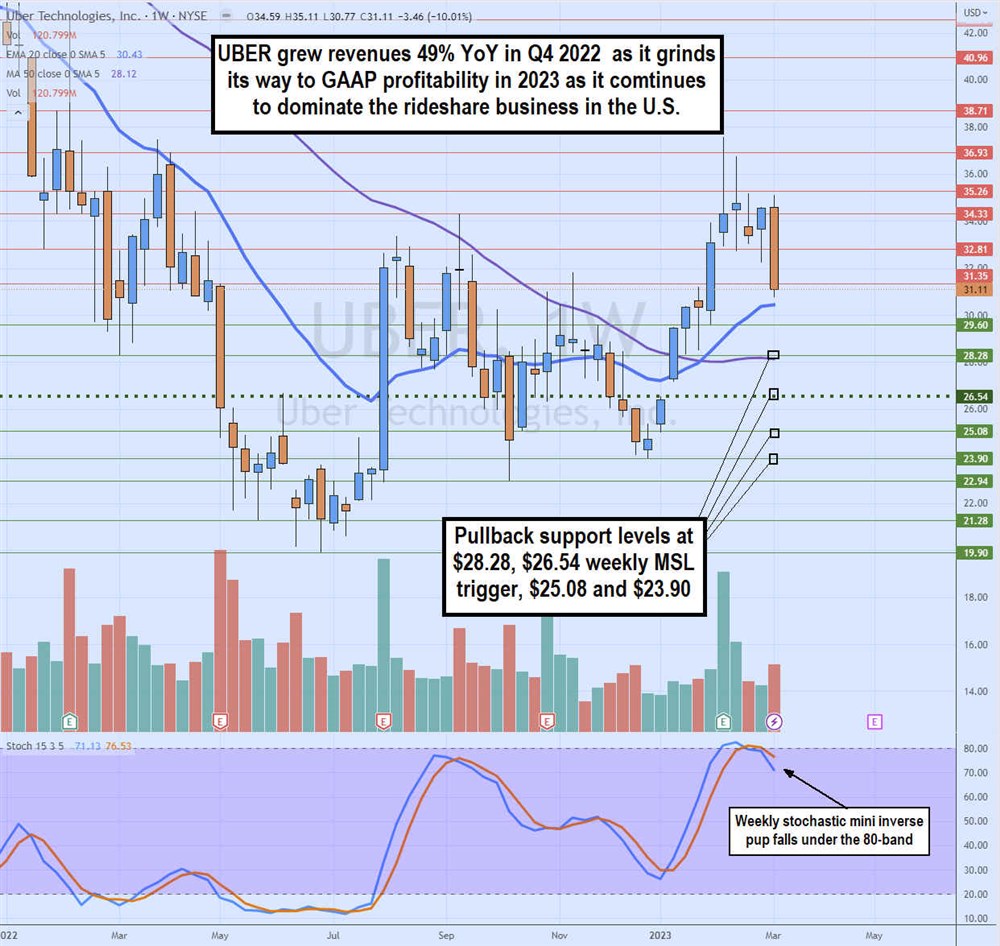
Let's face it, 2022 was an ugly year for the stock market, with the NASDAQ 100 falling (32.58%) and the S&P 500 falling (18.17%). Individual stocks performed even worse. The two bright areas of performance were in the energy and healthcare sectors. Rising interest rates sent bond yields higher, sending investors frantically rushing into fixed-income assets. Who would have guessed money market rates would spike up through 4%?
Unfortunately, Silicon Valley Bank (NASDAQ: SIVB) didn't believe it as they locked up nearly $100 billion in 1.79% yielding 3.6-year bonds betting interest rates would stay low. This backfired, causing a run on the bank, a failed funding raise, and ultimately insolvency in a matter of days as the FDIC took over. Most portfolios took a beating, and investors want to recover in 2023. Here are two beaten-down stocks that have the potential to help your portfolio recover in 2023.
Uber Technologies Inc. (NYSE: UBER)
What started as an unlicensed taxi operator slash money pit eventually blossomed into a juggernaut rideshare monopoly in the U.S. The company has an infamous history of breaking the rules, skirting the law, and bankrupting competitors. It spent billions of investor dollars to ruthlessly and aggressively grow market share and build its network with crazy payout bonuses for new drivers and cheap, subsidized rides for passengers (pax) to get them hooked.
The Drug Dealer Template for Early Growth
Like a drug dealer, Uber would enter a new neighborhood, give out free samples for potential riders and their friends, and offer significant bonuses for new drivers. All to get them hooked after trying the product. Drivers would earn big money, and pax would get cheap rides, like initially selling a $5 cheeseburger for $0.25. The goal was to build up the liquidity of numerous on-app live drivers to minimize wait times for numerous pax. This only works if the liquidity is there; it takes liquidity and tons of money to get there.
As liquidity built up, Uber would slowly wean down driver bonuses and raise rider fees taking a more significant cut. Despite outcries for driver pay and attempted government intervention to reclassify drivers' independent contractor status, Uber has been Teflon forcing local governments to bend to the will of the people and Uber.
Bending the Government Backwards
If the local taxi cartel convinces local governments to clamp down on regulations, Uber will threaten to leave the area, causing residents to complain. When Houston, Texas, called their bluff to force them to reform its rules in 2016, Uber followed through on its threat to leave. It up and left, leaving 10,000 drivers without a gig and numerous pax without rides. The bureaucrats believed that having Uber and Lyft Inc. (NASDAQ: LYFT) leave would open up the market for more competition as many startup rideshare ventures jumped in to fill the void.
They failed miserably as rideshare became even more fragmented, and thinly funded startups went bankrupt. A year later, a new Texas law was enacted, enabling Uber and other rideshare companies to offer their services again in Houston. That set the template moving forward for Uber’s dominance.
Becoming a Verb
Its name has achieved the rare distinction of becoming a verb, synonymous with ordering a ride with a private driver through an app anywhere and anytime. The pandemic re-opening bolstered its pandemic and fares as the company gets closer to actual GAAP profits.
Path to Profitability
Uber’s master plan (minus the autonomous driver network) is coming to fruition, GAAP profitability. Uber has become the dominant force in rideshare, and its metrics are growing substantially. As most companies that saw meteoric spikes during the re-opening are now facing normalization, Uber is continuing to break records. Enter 2023, from the analogy of offering $5 cheeseburgers for $0.25, Uber is now selling $5 cheeseburgers for $10 and higher, and the public can't get enough.

Its Q4 2022 was the "strongest quarter ever" as revenues rose 49% YoY to $8.61 billion. Its gross bookings grew 19% YoY to $30.7 billion. Rideshare mobility grew 31% YoY. Even its Uber Eats delivery business continued to grow 6% YoY. It even guided for 20% revenue growth for Q1 2023 as the company expects to be GAAP profitable by the end of the year. Pullback support levels are at $28.28, $26.54 weekly MSL trigger, $25.08, and $23.90.
The MarketBeat MarketRank™ Forecast gives it 2.5 out of 5 stars with a 51.5% upside price target of $47.13 per share.
SoFi Technologies Inc. (NASDAQ: SOFI)
While wealth management firms try to attract wealthy and established clients, SoFi attracts clients at the beginning of their careers as college students. Providing student loans for college students and bundling an all-in-one and one-stop shop for all things financial has been the perfect formula. The company attracts high-income millennial customers from their early years, offering student loans to banking services, mortgage financing, investing, retirement, and wealth planning services as they age. They have exemplified the network effect and fostered brand loyalty.
Fostering Generational Customers
Banks preach about generational customers but stick to the same song, dance, and lip service. SoFi fosters generational customers through the different financial stages of their lives. The company is profitable in its lending business. It grew deposits by 86% in Q3 2022. It's still building out its financial services, causing a drag on earnings. It grew Q4 2022 GAAP net revenues 60% YoY to $457 million, hitting record adjusted EBITDA of $70 million, up 15.3X YoY. It added 480,000 new members in Q4, growing its total membership to over 5.2 million, up 51% YoY. It had 695,000 new product adds in Q4 to 7.9 million, up 53% YoY. It looks to achieve GAAP profitability in Q4 2023. Pullback support levels are at $5.17, $4.88 weekly MSL trigger, $4.53, and $4.24 swing low.

The MarketBeat MarketRank™ Forecast gives it 2.5 out of 5 stars with a 50.8% upside price target of $8.42 per share.












